Search results
56 results found.
56 results found.
You thought Carnival was over with the sprinkling of the ashes on penitential hairdos? Not quite.
Carnival doesn’t slink away under cover of darkness when the marangon, the basso profundo bell in the campanile of San Marco, tolls midnight on Martedi Grasso. Two things have to happen for it to really be over — in my opinion, that is. Two things which are more predictable than the swallows returning to Capistrano.
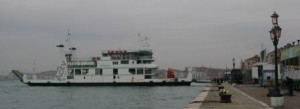
The first is the pulling apart and hauling away of the traveling amusement park (what they generically call a “Luna Park” here) which has been gracing the Riva dei Sette Martiri since — I believe — early December.
These people (as in much of the world) are almost exclusively families which have dedicated many generations to the setting up, operating, pulling down, and rolling on to the next location of their ride or concession stand.
After three months, I’m going to miss the smell of the hot-doughnut-frying-oil and the screeching of the children. It was fun strolling along the waterfront late every afternoon to mingle and kibitz. And I am convinced that as long as there is at least one small child walking home carrying a small plastic bag containing water and a goldfish, the world will not come to an end.
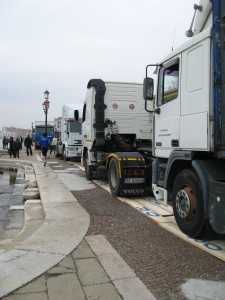
Anyway, the men start work early on Ash Wednesday morning, and by Thursday morning the funfair is gone. The only sign they’ve ever been here are the patches of new cement filling the holes in the pavement where their big rigs (or something) went astray.
Speaking of itinerant carnies, I went to the small town of Bergantino a few years ago when I was working on a story about the Po River (National Geographic, May, 2002). This former farming town has, since the Twenties and much more since the Sixties, become dedicated to the design, construction, and (eventually) operation of carnival rides — merry-go-rounds, bumper cars, etc. Despite the town’s modest size — it’s really just a village of some 2,000 people, when they’re all there, I mean, and not out on the road — they’ve carved away a heavy slice of this international industry for Italy. One of the major markets for their inventions is the USA.
Well, wherever they’ve gone, I’m already missing them.
The second element of the end of Carnival is the orgy of articles, editorials, and letters in the Gazzettino reviewing, celebrating, and vilifying the festivities just concluded. I can tell you without even having opened the paper that there will have been too many people for this fragile city to support; that the managing of this predictable overload will have shown inexcusable organizational flaws and failures to resolve the most elementary large-event necessities (toilets, in a word); that the money taken in doesn’t justify the stress and expense to the city; that it will have lacked originality and creative genius, and that for the residents and shopkeepers of Campo Santa Margherita, the ten days just concluded have been nothing less than at least six of the nine rings of hell.
And every year, the apex of all the claims and counter-claims: That this event would be (or ought to have been, or next year definitely will be) the “Carnival of the Venetians.” I saw Venetians having a fine time carnivalizing in their own modest way in various neighborhoods of the city, but not in the Piazza San Marco. I’d have given you a cash prize if you’d found any Venetians besides Lino in the Piazza San Marco.
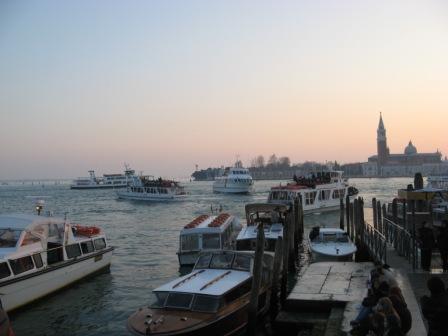
So when this wish to involve Venetians is mentioned, as if it were obviously a good thing, I ask myself if the speaker believes that a “Carnival of the Venetians” would have the slightest probability of pouring the millions of euros into the municipal strongboxes that all those tourists do. After all, Venetians don’t spend money on hotel rooms, restaurant meals, fancy masks, or whatever else makes Carnival matter. So frankly, what would be the point of spending money to organize a ten-day carnival for the few remaining locals? Just wondering.
Let’s go to the videotape (so to speak). Here is a smattering of the Gazzettino’s overview of Carnival 2010, as published yesterday:
The organizers claim that 150,000 people came the first Sunday; 250,000 the second Sunday (let that sink in…) and 40,000 on Martedi Grasso. Altogether, they say a total of 800,000 people came to Venice during Carnival. Perhaps not much compared to Rio, but for a city that covers a mere three square miles, not bad.
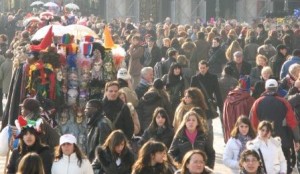 They estimate that each visitor spent 50 euros, for an exciting total income of 40 million euros. Not sure where this number came from; a professor of the Economics of Tourism at the University of Venice says that the “bite and run” day-trippers spend an average of 30 euros each day, while the more solid tourist spends 150. In any case, let’s not quibble over a million more or a million less. Restaurants and hotels certainly made money, not to mention the ACTV and their spectacularly expensive vaporetto tickets.
They estimate that each visitor spent 50 euros, for an exciting total income of 40 million euros. Not sure where this number came from; a professor of the Economics of Tourism at the University of Venice says that the “bite and run” day-trippers spend an average of 30 euros each day, while the more solid tourist spends 150. In any case, let’s not quibble over a million more or a million less. Restaurants and hotels certainly made money, not to mention the ACTV and their spectacularly expensive vaporetto tickets.
One new comment is by the businesspeople (especiallythose of restaurants and cafes) in the Piazza San Marco — they don’t want a maxi-stage there anymore. I’m not sure why, but I imagine it’s because it takes up too much space which needs to be available for them to put out their tables and chairs.
I could go on, but it’s probably not that interesting. These few days following Carnival are mainly spent in a sort of emotional and mental scrubbing and disinfecting.
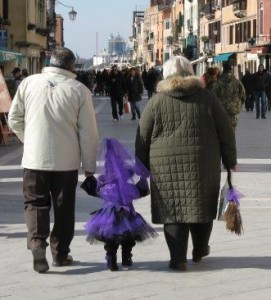
The summary is fairly concise. Apart from numbers, claims, and counter-claims as to success or failure, as one reporter wrote, “Now the Venetians can give a deep sigh of relief and put their hands on their foreheads and say, “‘Once again we’ve lived through it.'”

There are just too many curious things about the way Carnival was back in the Great Days, so I’m only going to tell you a few of the ones I think are interesting. Anyway, it’s not as if they have any relevance now. For all the roar of media coverage today, what goes on here is a hoarse whisper compared to the cacophony that was Carnival before 1797.
And Paris must be deserted; there are nothing but French people in town.
For many centuries, Carnival here was primarily a Venetian phenomenon, which is to say an integral part of Venetian life and culture. But when Vasco da Gama reached the Spice Islands by means of a daring new route round the Cape of Good Hope (1497), Venice’s monopoly of the spice trade collapsed virtually overnight, dragging the city’s economy down with it.
Struggling to get the city back on its feet, somebody began to put the word out that the Venice Carnival was one heck of a thing to see. Yes, Venice could discern its potential for tourism even before the invention of bullets and parachutes, and the Venetian merchants, staring into their now-empty coffers, were quick to make the most of it.
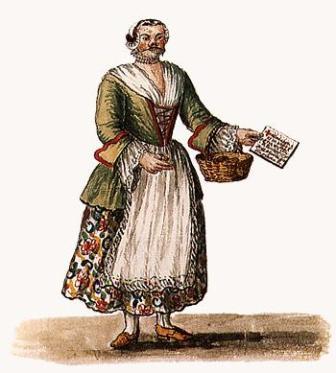
The wildly absurd and equally wildly obscene elements which so many favored (I refer to behavior as much as garb) were not simply a crucial social safety valve (keeping in mind that the patricians lived with loads of restrictions, too — it wasn’t just the salt of the earth that needed a break). It appears that people have always exploited the absurd and the obscene as a way of exorcising their dread of death and the demonic, and Carnival was the Olympics of spitting in the face of fear, as well as in the face of manners and rules and occasionally, I imagine, other people.
Sir Thomas More famously stated that “The devil, a proud spirit, cannot endure to be mocked,” so the broader, sharper, and deeper the derision, the better. That went double for the rude and the lewd. So really, unless you were putting somebody life or savings in danger, there was no such thing as too wild, too crude, too raunchy– too anything. They organized races for boats rowed by dwarfs, or the blind.
 The white mask often called a bauta is more correctly termed “Volto“ (face) or “Larva.” Sounds repellent, but it comes from the Latin meaning ghost, specter, minor evil spirit. Its extraordinary shape resolves several important concerns: First, it completely hides the face; second, it leaves space for the wearer to eat and drink; third, its shape alters the speaker’s voice, thereby acting as a kind of vocal, as well as visual, disguise.
The white mask often called a bauta is more correctly termed “Volto“ (face) or “Larva.” Sounds repellent, but it comes from the Latin meaning ghost, specter, minor evil spirit. Its extraordinary shape resolves several important concerns: First, it completely hides the face; second, it leaves space for the wearer to eat and drink; third, its shape alters the speaker’s voice, thereby acting as a kind of vocal, as well as visual, disguise.  I think my favorite is the “Moretta,” or “Servetta Muta.” It’s so strange it could only have come from France (it did), and it started out, at least, as something to be worn by women when they went to visit a convent. It was usually made of black velvet, and wasn’t attached by ribbons; you kept it on your face by biting down on a small button attached to the faceward side. (Hence the term “mute.”)
I think my favorite is the “Moretta,” or “Servetta Muta.” It’s so strange it could only have come from France (it did), and it started out, at least, as something to be worn by women when they went to visit a convent. It was usually made of black velvet, and wasn’t attached by ribbons; you kept it on your face by biting down on a small button attached to the faceward side. (Hence the term “mute.”)
I can see what the appeal would be for men, but if you couldn’t speak, why would you go visit someone in a convent in the first place? To give the nuns a chance to talk?

I’m not a big fan of Carnival in Venice. The only bigness I can evince where this annual demolition derby is concerned is a jumbo-size package of the old Aristotelian pity and terror.
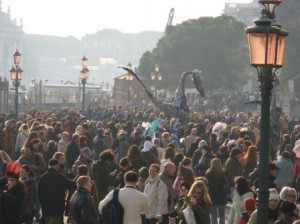
That’s not completely true: I don’t feel pity.
But this year I decided to take a different approach. When Carnival erupted last Sunday (after several premonitory tremors) I thought I’d imagine it was something that could be fun, amusing, diverting, worth the trip. Not for me — I’ve figured out how to make it fun for me but it doesn’t involve costumes or the Piazza San Marco — but just going with the idea that it could be entertaining for the thousands upon thousands of people who come to Venice expecting to enjoy themselves, at least, if not enjoy everybody else.
By which I mean, enjoy being squashed like a grape in a winepress by your fellow humans.
So far, it’s working. I had a fine time on Sunday afternoon. But that’s because I made a point of not going to the Piazza San Marco. The Gazzettino reported that some 90,000 people were there. They certainly didn’t need me, even if there had been room.
The first years I was here I did go, at least a few times, to the Piazza San Marco, the gravitational center of the festivities. It was all so new and strange, and memory reports that there weren’t quite so many thousands. Memory may be lying but it was fine anyway. Perhaps the novelty of the situation carried me over the crush, as it may well do to people today.

Then there was a hiatus, partly because I didn’t enjoy the winepress experience and also because what was going on there seemed strangely unfestive: Loads of people in costume (95 percent of which seemed to be identical), walking around just looking at each other, striking attitudes, or taking pictures of each other with or without tourists posing next to them. The nadir is occupied by the people in costume who charge money for allowing themselves to be photographed with your cousin or your kid. And they can make a bundle.
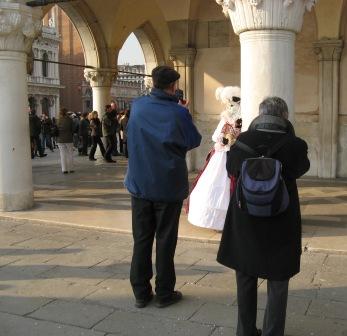


Then we came to Castello and I discovered something of the way Carnival was, decades ago, before the event was trampled by the tourism behemoth. Kids and families and dogs, and relatively few tourists. And did I mention the kids?
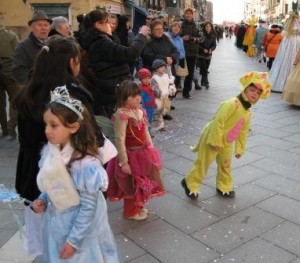
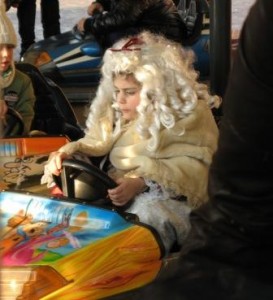
Perhaps I’m going senile, or perhaps it’s because the confetti-throwing and occasional Silly String-spraying and strolling around have no evident commercial focus, but I think the downtown version of Carnival beats San Marco in straight sets. Here, if you see somebody taking a picture of a person in costume, it’s almost certainly a besotted relative.
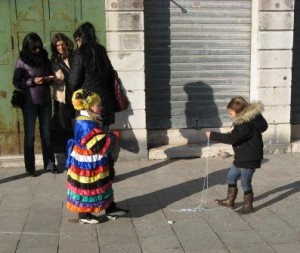
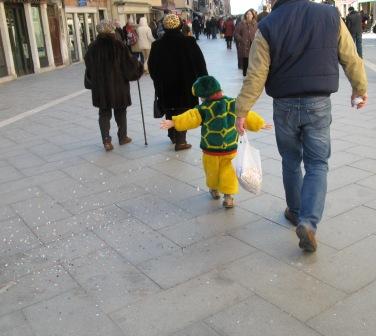
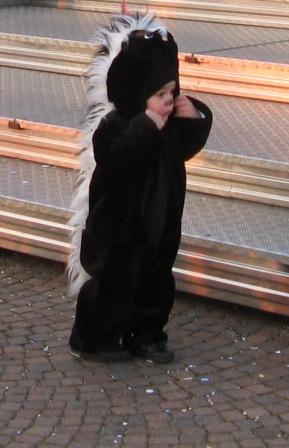
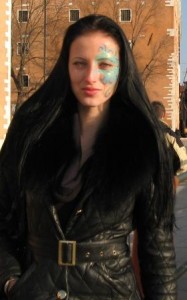
I
If you start to look around, you begin to notice how little it really takes to dress up and play Carnival. There were people who were looking great with only a hat, or a wig, or a moustache or whiskers scribbled on with a black marker– even the simplest mask imaginable just barely covering the eyes. No plumes, no sequins, no layers of painted papier-mache. It really works.
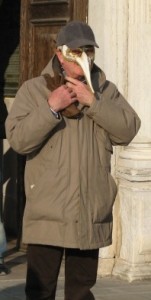
The first Sunday of Carnival (February 7 this year) was Opening Day, one of the maximum moments, as you can imagine. The others are Fat Thursday (Giovedi’ Grasso), and Fat Tuesday (Martedi’ Grasso). And the weekend between them. If the weather is beautiful — as it was on Sunday — it can feel like a party even if you don’t do anything special. If it’s really cold, overcast, windy or rainy, obviously the merriment becomes shredded and forced. This isn’t Rio.
Next chapter: I’ll be tossing out a few festive fistfuls of history, gathered from a large bag of brightly-colored bits of trivia.
Here’s a sample. “Confetti” here refers to the sugared almonds which are given to wedding guests. What speakers of English (and French, German, Spanish, Swedish and Dutch) call confetti — brightly-colored bits of paper — here are called coriandoli (ko-ree-AN-dolee). Why?
Because back in the Olden Days, Carnival revelers would toss all sorts of things around or at or on each other — eggs full of rosewater was one hugely amusing toy to everybody except the women who were on the receiving end. People would also toss various tiny edibles, particularly coriander seeds, which were used in pastries. Then they became bits of sugar pretending to be coriander seeds. Only much later — in 1875 — did flakes of paper begin to be used instead, which is an entirely different story. People who had always called the flying fragments of food “coriandoli” merely transferred to term to the newer-fangled form.
“Motondoso” has very clear, and essentially simple, causes and effects. Anything moving in water, even eels, will create some kind of wake. The wake is the visible, surface part of the turbulence made by whatever is moving — in the present case, the motor’s propellers. The waves spread out in two directions until they dissipate.
In the case of motorboats in Venice, this fact is exacerbated by:

The number of boats: There are thousands of registered boats in the city of Venice. There are also many which are unregistered. This number spikes every year in the summer when trippers from the hinterland come into the lagoon to spend their weekends roaming around, often at high speed but always with many horsepower, in motorboats of every shape and tonnage. Teenage boys, particularly from the islands (by which we mean Sant’ Erasmo, Burano, Murano, are especially addicted to roaming at high speed at all hours with their girlfriends and boomboxes.
On a Sunday in July a few years ago, a squad of volunteers from the Venice Project Center spread out at observation posts across the lagoon, from Chioggia to Burano. Their mission was to count the number and type of boats that passed their station. Whether it was a million boats passing once or one boat a million times, it didn’t matter. They came home with quite a list: every kind of small-to-smallish boat with motors ranging from 15 to 150 hp, hulking great Zodiacs, large cabin cruisers, ferries, vaporettos, tourist mega-launches, hydrofoils from Croatia, taxis, and more. After 11 hours, from 8:30 AM to 7:30 PM, they analyzed their data. Result: A motorboat had passed somewhere, on the average, every one and a half seconds.
And if weekday traffic is heavy, weekend traffic is three times greater.
The types of boats: In the last 20 years, motor-powered traffic has doubled; at last count 30,000 trips are made in the city every day; 97 percent of these trips are in boats with motors. (There are currently 12 projects in the works for marinas which will add 8,000 more berths.) Of these 30,000 trips, a little over half are made by some sort of working boat.
More than 10,000 daily trips are by taxis or mega-launches, and more than 8,000 are by barges carrying some kind of goods (bricks, plumbing supplies, cream puffs, etc.). Studies have shown that if there is one category that over time causes the most damage, it’s not the taxi (I would have bet money on that). It’s barges. And they are everywhere. It’s all barges, all the time.
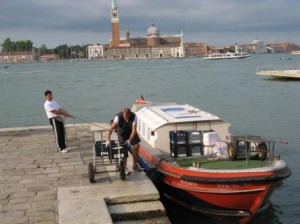
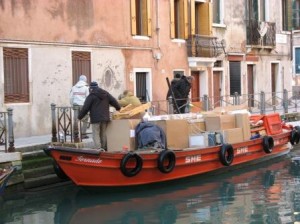

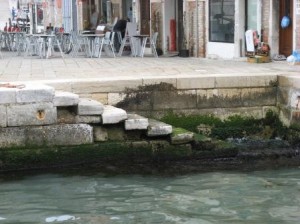
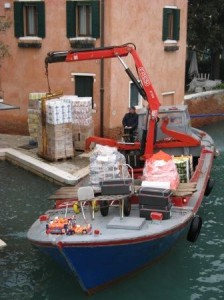
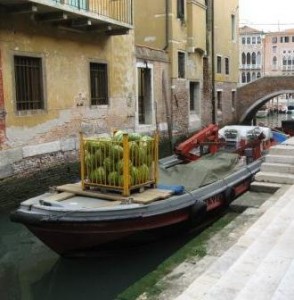
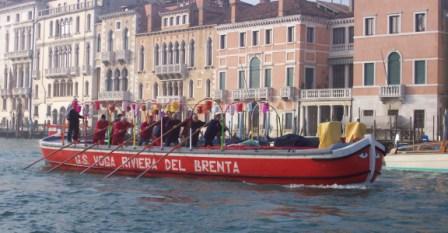
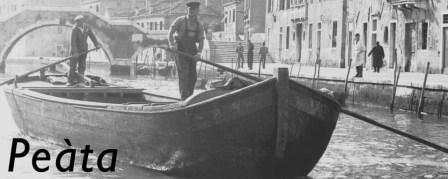
Traffic patterns: The problem isn’t merely the number and type of boats, but where they are. Obviously, the more boats you have, the more waves they will create, and where space is limited (most canals in Venice) these waves quickly accumulate into a roiling mass that dissipates with extreme difficulty. They are forced to go back and forth, hitting anything they come into contact with, until they finally wear themselves out and die.
There are canals where the waves don’t expire for hours: the Grand Canal (unfortunately), the Rio Novo, the Rio di Noale, the Canale di Tessera toward the airport, the Canale delle Fondamente Nuove, and above all, the Canale della Giudecca.
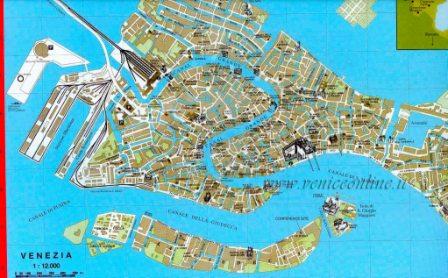
This broad, deep channel has become Venice’s Cape Horn. It is a stretch of water 1.5 miles long [2 km] and 1,581 feet [482 m] wide, and is the shortest and fastest way to get from the Maritime Zone (cruise ship passengers, tourist groups from buses at Tronchetto, barges delivering goods of every sort) to the Bacino of San Marco. One study revealed that the biggest waves in the Lagoon are here; an even more recent survey, conducted with a new telecamera system installed by the Capitaneria di Porto, provided some specific numbers: 1,000 boats an hour transit here, or 10,000 in an ordinary workday. In the summer, there are undoubtedly more, seeing that an “ordinary workday” includes masses of tourists.
One reason there are so many boats is due to the large number of barges, rendered necessary by an exotic system for distributing goods. If you are a restaurant and need paper products, they come on a barge. If you need tomato paste, it comes on another barge. If you need wine, it comes on another barge. In one especially busy internal canal, the amount of cargo and number of barges was analyzed, and it turns out that the stuff on 96 barges could have fit onto three. But never forget the fundamental philosophy: “Io devo lavorare” (I have to work).
The types of boats: Their weight and length. The shape of their hulls. Their motors (horsepower and propeller shape). All these factors influence the waves that they create.
A number of intelligent and effective changes have been proposed over time, most of which that would not be particularly complicated, but which would cost money. So far no one has shown that they consider these changes to be a worthwhile investment.
Example: The original motor taxis (c. 1930), apart from being smaller than those of today, positioned their motors in the center of the boat. When the hulls (and motors) became larger, everyone moved the motor to the stern, which immediately creates bigger waves. But subsequent improvement in motors and their fuels means that today it would be feasible to maintain the current size of the taxi while moving the motor to the center once again, thereby immediately minimizing its waves. Feasible, but no one is interested.
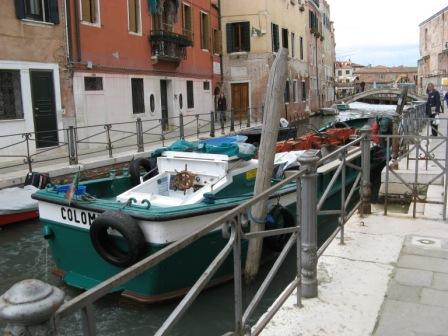
Speed: This is utterly fundamental. Speed limits were introduced in 2002 to confront the already serious problem of the waves; the average legal range, depending on what canal you’re in, is between 5-7 km/h. But tourist mega-launches, barges, taxis — almost every motorized boat in Venice has the same need: To get where they’re going as quickly as possible.
This need has been imposed by the demands of mass tourism, which involves moving the maximum amount of cargo (people, laundry, bottled water, etc.) often many times during the day. Everyone makes up a timetable which suits them and then makes it work.
Studies by the Venice Project Center have revealed several speedy facts in crisp detail.
Speed limits would have a positive effect (if they were obeyed) but only if certain laws of hydrodynamics were taken into account, such as the one governing the wake produced relative to the weight of the boat. Here the speed limits have been adjusted to permit the vaporettos (waterbuses), among the heaviest daily craft, to go — not slower, which would be correct — but as fast as the timetable requires.
You can change the laws on speed limits all you want — you’ll never change the laws of physics.
Oh yes: there will be waves.
Next: Part Four: The lagoon experience